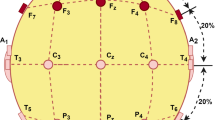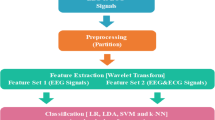Abstract
Cognitive task produces activation in the brain which are different from normal state. In order to study the brain behavior during cognitive state, different techniques are available. Wavelet energy and power spectral density (PSD) are well established methods for brain signal classification. In this paper, cognitive state of the brain is compared with the baseline using EEG. Data are taken from all lobes of the brain to see the effect of cognitive task in the whole brain and analyzed using wavelet energy and PSD. Graph of wavelet energy and power spectral density are plotted separately for each subject to see the effect individually. Individual results showed that the behavior of human brain change with the cognitive task and this change occurred in most of the human brain. This change is due to the neural activity which is increased during the cognitive task (IQ) and is better measured with wavelet compared to PSD.
Access this chapter
Tax calculation will be finalised at checkout
Purchases are for personal use only
Similar content being viewed by others
References
Zafar, R., et al.: Decoding of visual information from human brain activity: a review of fMRI and EEG studies. J. Integrative Neurosci. 14(2), 1–14 (2015)
Locke, H.S., Braver, T.S.: Motivational influences on cognitive control: behavior, brain activation, and individual differences. Cogn. Affect. Behav. Neurosci. 8, 99–112 (2008)
Amin, H.U., et al.: Brain activation during cognitive tasks: an overview of EEG and fMRI studies. In: 2012 IEEE EMBS Conference on Biomedical Engineering and Sciences (IECBES), pp. 950–953 (2012)
Zafar, R., et al.: EEG Spectral Analysis during Complex Cognitive Task at Occipital (2014)
Trejo, L.J., et al.: Measures and models for predicting cognitive fatigue. In: Defense and Security, pp. 105–115 (2005)
Kramer, A.F., et al.: Psychophysiological measures of workload- potential applications to adaptively automated systems. Automation and Human Performance: Theory and Applications (A 98-12010 01-54), Mahwah, NJ, Lawrence Erlbaum Associates, Publishers, pp. 137–162 (1996)
Humphrey, D.G., et al.: Influence of extended wakefulness on automatic and nonautomatic processing. Hum. Fact. J. Hum. Fact. Ergonomics Soc. 36, 652–669 (1994)
Sternberg, R.J.: The theory of successful intelligence. Interam. J. Psychol. 39, 189–202 (2005)
Lan, T., et al.: Estimating cognitive state using EEG signals. J. Mach. Learn. 4, 1261–1269 (2003)
Pan, J., et al.: Discrimination between control and idle states in asynchronous SSVEP-based brain switches: a pseudo-key-based approach. IEEE Trans. Neural Syst. Rehabil. Eng. 21, 435–443 (2013)
Abdul-latif, A.A., et al.: Power changes of EEG signals associated with muscle fatigue: the root mean square analysis of EEG bands. In: Proceedings of the 2004 Intelligent Sensors, Sensor Networks and Information Processing Conference, pp. 531–534 (2004)
Hoffmann, S., Falkenstein, M.: The correction of eye blink artefacts in the EEG: a comparison of two prominent methods. PLoS ONE 3, e3004 (2008)
Acknowledgment
This research has been funded by University Research Internal Funding (URIF: 0153AA-B26) and international grant (0153AB-E15), Universiti Teknologi PETRONAS, Malaysia.
Author information
Authors and Affiliations
Corresponding author
Editor information
Editors and Affiliations
Rights and permissions
Copyright information
© 2015 Springer International Publishing Switzerland
About this paper
Cite this paper
Zafar, R., Malik, A.S., Amin, H.U., Kamel, N., Dass, S.C. (2015). Discrimination of Brain States Using Wavelet and Power Spectral Density. In: Arik, S., Huang, T., Lai, W., Liu, Q. (eds) Neural Information Processing. ICONIP 2015. Lecture Notes in Computer Science(), vol 9492. Springer, Cham. https://doi.org/10.1007/978-3-319-26561-2_41
Download citation
DOI: https://doi.org/10.1007/978-3-319-26561-2_41
Published:
Publisher Name: Springer, Cham
Print ISBN: 978-3-319-26560-5
Online ISBN: 978-3-319-26561-2
eBook Packages: Computer ScienceComputer Science (R0)




